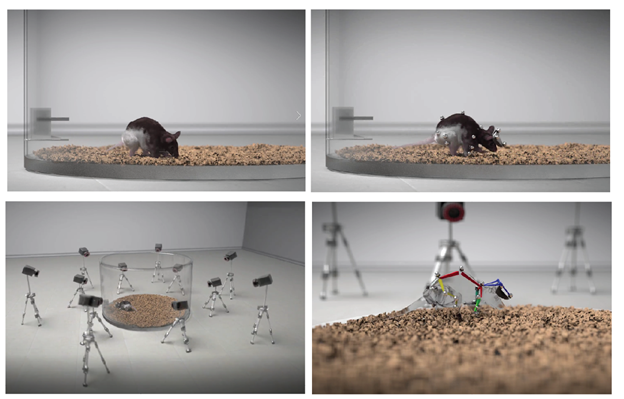by Jesse Marshall
Neuroscientists devote the majority of their attention to studying the brain. We marvel at the exquisite dendritic arbors of Purkinje cells in the cerebellum, the diversity of cell types in the cerebral cortex, and ponder with awe the mysterious patterns of spiking activity that lead to consciousness. To satisfy their curiosities, neuroscientists have been building new tools to study the brain, and in the last decade, a technological revolution has taken place. Fueled by funding from the BRAIN initiative, a dizzying array of new methods for measuring and manipulating neural circuitry were introduced, from scanning electron microscopes capable of measuring neural anatomy with 1/100,000th the thickness of a human hair to fluorescent microscopes that can monitor the activity of tens of thousands of neurons at once.

Artists rendering of CAPTURE. Credit: Kristian Herrera, Jesse Marshall, Bence Olveczky.
However, in all our haste to measure the activity and structure of the brain, we lost track of some of the broader goals of neuroscience. The primary function of the brain is to produce behavior, but in comparison to the glittery new tools that have been created for studying the brain in recent years, our ability to measure and quantify the behavior of animals is still quite poor. Many studies (including my own past studies) got by simply by tracking the overall speed of animals, coarse measures that fail to reflect the rich set of behaviors animals perform.
To precisely track the behavior of animals, we took inspiration from Hollywood, where a technique known as motion capture, allows human actors to be turned into animated characters like Gollum. Motion capture works by putting actors in suits outfitted with special markers that are tracked by a large camera array, allowing the markers’ position to be triangulated in 3D. Motion capture is a powerful way to track behavior, but it is difficult to put the rodents we typically use for neuroscience experiments in marker-clad suits for any length of time. To get around this, we adapted another technique long used in humans: body piercing. We developed a custom set of glass markers that were indestructible to rodents, and chronically attached them using body piercings.
The resulting technique, CAPTURE (Continuous Appendicular and Postural Tracking using Retroreflector Embedding), allowed us to track the precise kinematics of twenty points on a rat’s head, trunk, continuously, across the full repertoire of behavior our animals performed. CAPTURE is a powerful tool for examining the structure of behavior in space and time, which we demonstrated by constructing exact kinematic ‘fingerprints’ for different behaviors and studying the long-timescale organization of behavior into sequences and states. CAPTURE is also a powerful tool for phenotyping, which we demonstrated by describing the behavioral changes that occur after administration of drugs, in a rat model of autism spectral disorder, and across individuals. These experiments revealed how different drugs can manipulate not only the frequency of different behaviors, but also their long-timescale organization.

CAPTURE. Top Left: We let an animal explore an open field arena and attach a set of 20 retroreflective markers to the animal’s head, trunk, and limbs, using body piercings (Top Right). We use a calibrated 12 camera array to reconstruct the position of markers in 3D (Bottom Left), allowing us to reconstruct the animal’s full pose (Bottom Right).
Going forward, CAPTURE should enable the development of new, markerless, approaches for behavioral tracking, by enabling the construction of large training datasets for deep learning-based approaches for pose detection. CAPTURE also offers a far more comprehensive way of interrogating the relationship between the brain and behavior than past approaches, allowing us to fully exploit the advances of the last decade.
Jesse Marshall is a postdoc in the lab of Bence P Ölveczky at Harvard.
Learn more in the original research article:
Continuous Whole-Body 3D Kinematic Recordings across the Rodent Behavioral Repertoire
Marshall JD, Aldarondo DE, Dunn TW, Wang WL, Berman GJ, Ölveczky BP. Neuron. 2021 Feb 3;109(3):420-437.e8. doi: 10.1016/j.neuron.2020.11.016. Epub 2020 Dec 18. PMID: 33340448; PMCID: PMC7864892.
News Types: Community Stories
